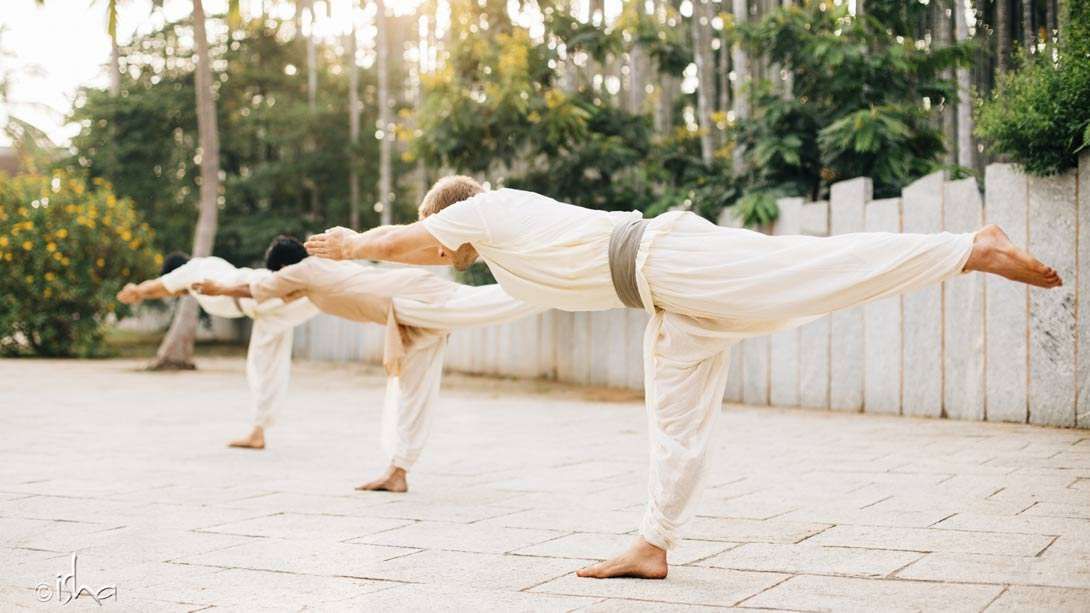The Anatomy of Angamardana
Angamardana is a system of dynamic exercises that invigorate the body on all levels. Sadhguru looks at how Angamardana builds resilience and strengthens the fundamental fabric of the body.

Q: I have been practicing Angamardana for the past three-and-a-half months now, and I would like to take it to the next level. How to do that?
Sadhguru: If you want to take Angamardana to the next stage, your body must become very supple – otherwise you may suffer a tear. Angamardana works on the ligaments and sinews of the body more than the muscles. It is not like lifting weights. Weightlifting builds muscle. If you do Angamardana, the load will be on the ligaments and sinews. The “bands” that hold the skeletal system and muscles together are stretched the most. This is why Angamardana gives you a different kind of strength and resilience.
Strengthening the Fundamental Fabric
If you build muscle beyond a certain point, you will need a lot of sleep. The body has to do too much unnecessary work. If you become very muscular, you cannot sit with your eyes closed. If strength and resilience is what you are looking for, you need to strengthen the fundamental fabric of the body. This is what Angamardana does. If you suddenly overstretch and get a tear, it will not heal easily. A broken bone can heal in six weeks. A torn ligament is much more difficult to heal because this is what holds the skeletal structure together. This strengthening takes time. After at least thirty months of daily practice, some people’s bodies will be ready for advanced Angamardana. The advanced practices involve stretching to extremes, which is not necessary for normal living. This would only be required for somebody who wants to climb rocks without ropes, for example.
Subscribe
When I was young, I could climb just about anything. Just a small hold of half-an-inch depth was enough for me. The entire load of the body was on this small area. I have said this many times – when I was twelve years of age, I once saw this over seventy-year-old man climbing up a fifty-five to sixty feet deep well, on holds that were just deep enough to grip them with your fingertips, faster than me. Obviously he had prepared his body way better than me. At that time, I had not done any Angamardana. My training was just to climb every tree and structure that I saw. He had systematically trained himself.
Traditional martial arts such as kalaripayattu also require this kind of strengthening to be able to fight without damaging the system. Boxers and American football players often end up with neurological ailments in the later part of their lives – like Muhammad Ali and many others. Having a strong will to win, such people will succeed for a period of time, but their system will take a beating. This is not to be judgmental about them – they are great in their own way. It is just that they have been thrashed on the head too much. Not just that – even punching something constantly can have a jarring effect on one’s own system. Even if the muscles are strong, strengthening the fundamental fabric of the body is a different game.
In the Himalayan regions of India and Nepal, you will see women who are barely four-and-a-half to five feet tall, looking frail and malnourished. These women may not weigh more than forty-five kilograms, but they carry a load of wood or other things that is sixty-five to seventy kilograms. Their system has become so strong because from an early age, living in the mountains, they have been walking up and down the mountain slopes, carrying loads. You should see the Sherpa boys who come with us on the Kailash trek. Once, when we climbed the Thorong La pass, which is at an altitude of 17,800 ft, participants were panting for air with every step. I was doing way better than most of the group, but these Sherpa boys that were with us were carrying the whole baggage, gas cylinders, cooking equipment, etc. on top of everything else. When we reached there, all of us sat down, glad that our hearts did not fail, and waited for our breath and heartbeat to settle down. These guys threw the baggage down and instantly started running around, chasing each other, leaping upon each other, fighting and rolling around, just for fun – at this altitude. This is the kind of resilience that is built right from childhood. These are not only aerobic capabilities – their basic fabric of life is strong.
A Different Level of Strength
Similarly with Angamardana, it builds a different level of strength. This is not about building muscles but about strengthening the ligaments. Once you strengthen them, they will keep you in good stead for a lifetime. The regular Angamardana that we teach serves this purpose perfectly well. If you want to intensify the practice, you can do it twice over. Some people may think they are fit enough to take Angamardana to the next level, but if you look more closely, you will see the bane of modern civilization is that human beings are losing their form. Still, at some point, we will introduce the next level of Angamardana, but only if people are dedicated enough to adequately prepare their system.
Editor’s Note: Isha Hatha Yoga programs are an extensive exploration of classical hatha yoga, which revive various dimensions of this ancient science that are largely absent in the world today. These programs offer an unparalleled opportunity to explore Upa-yoga, Angamardana, Surya Kriya, Surya Shakti, Yogasanas and Bhuta Shuddhi, among other potent yogic practices.
Find Hatha Yoga Program Near You
A version of this article was originally published in Isha Forest Flower. Download as PDF on a “name your price, no minimum” basis or subscribe to the print version.




